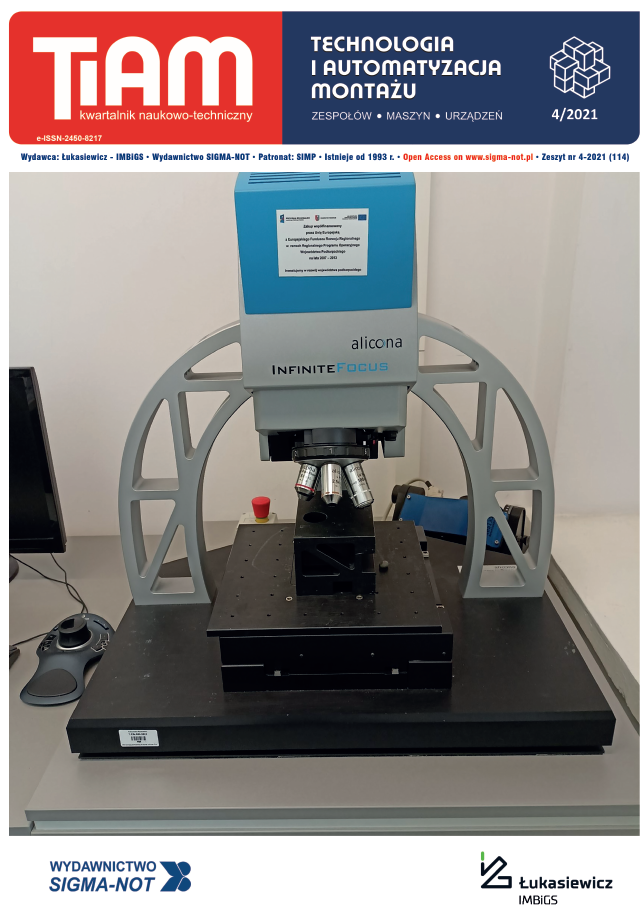Abstract
This paper presents a computational study on an influence of a rough surface on the fluid flow in a microchannel used in various technical microdevices of complex products. Two-dimensional axially symmetrical microchannels with a circular cross-section were considered. The fluid flow were simulated as simple geometric figures, i.e. a triangle and a rectangle with different height h and different distance s between each other. The flow equations were solved with Ansys / Fluent software. A streamline analysis is performed to investigate the flows in the recirculation zone behind the roughness elements. It was found that the friction factor increases with increasing height of rough elements. The coefficient of friction factor is greater for rectangular elements than for triangular elements, and decreases as the geometry of the element changes. Friction factor decreases as the Reynolds number increases. The authors indicate that in the production of microchannels of complex products, it is recommended to use triangular elements to model roughness.
This is an Open Access article distributed under the terms of the Creative Commons Attribution License CC BY 4.0 (https://creativecommons.org/licenses/by/4.0/)
References
Dai Baomin; Li Minxia & Ma, Yitai. 2014. „Effect of sur¬face roughness on liquid friction and transition charac¬teristics in micro- and mini-channels”. Applied Thermal Engineering 67 (1–2): 283–293. doi:10.1016/j.appltherma¬leng.2014.03.028.
Datta Aparesh et al. 2019. „A review of liquid flow and heat transfer in microchannels with emphasis to electronic cooling”. Sādhanā 44 (12) (abenduak 15): 234. doi:10.1007/ s12046-019-1201-2. http://link.springer.com/10.1007/ s12046-019-1201-2.
Kandlikar S. G. 2005. „Roughness effects at microscale - Reassessing Nikuradse’s experiments on liquid flow in rough tubes”. Bulletin of the Polish Academy of Sciences: Technical Sciences 53 (4): 343–349.
Kandlikar S. G., Dongqing Li, Stéphane Colin, Srinivas S. Garimella and M. King. 2006.. Heat Transfer and Fluid Flow in Minichannels and Microchannels. Elsevier.. doi:10.1016/ B978-0-08-044527-4.X5000-2.
Kmiotek M. & Kucaba-Piȩtal, A. 2018. „Influence of slim ob¬stacle geometry on the flow and heat transfer in microchan¬nels”. Bulletin of the Polish Academy of Sciences: Technical Sciences 66 (2): 111–118. doi:10.24425/119064.
Lalegani Fakhrodin et al. 2018. „Effects of different rough¬ness elements on friction and pressure drop of laminar flow in microchannels”. International Journal of Numerical Me¬thods for Heat & Fluid Flow 28 (7) (uztailak): 1664–1683. doi:10.1108/HFF-04-2017-0140.
Mohiuddin Mala, Gh. & Li, Dongqing. 1999. „Flow characte¬ristics of water in microtubes”. International Journal of Heat and Fluid Flow 20 (2) (apirilak): 142–148. doi:10.1016/ S0142-727X(98)10043-7.
Whitehouse, David. 2004. Surfaces and their Measure¬ment. Butterworth-Heinemann.
Zhang, Chengbin; Chen, Yongping & Shi, Mingheng. 2010. „Effects of roughness elements on laminar flow and heat transfer in microchannels”. Chemical Engineering and Pro¬cessing: Process Intensification 49 (11) (azaroak): 1188– 1192. doi:10.1016/j.cep.2010.08.022.


